South China Sea: China building more islands?
Is China building more islands in the disputed waters of the South China Sea?
The Philippines military this week released images of Chinese ships it said were capable of dredging sand around the Scarborough Shoal -- a small but strategic reef and fertile fishing ground 130 miles (200 kilometers) west from the Philippine island of Luzon.
Beijing has denied it is reclaiming land, saying that while Chinese coast guard vessels patrol the waters around the shoal, which it calls Huangyandao, they were there for "law enforcement."

The Philippines has released images of Chinese ships it says are capable of dredging near the disputed Scarborough Shoal.
"The situation has not changed. There are no dredging or building activities there," said a statement from the Chinese Embassy in Manila.
Presidential spokesman Ernesto Abella said the Philippines was seeking clarification from Beijing about the ships.
It's one of a number of disputed islands and reefs in the South China Sea, which is home to a messy territorial dispute.
Abella said Manila was communicating with Chinese officials on the presence of the ships, through diplomatic and "back door" channels -- primarily through the country's special envoy to China, former President Fidel Ramos.

Could South China Sea be next global conflict?
The images were released shortly before leaders from the Association of Southeast Asian Nations (ASEAN) and Chinese leaders met in Laos for a regional summit.
In the chairman's statement on Wednesday, ASEAN said that land reclamation and "escalation of activities" in the waters had "eroded trust and confidence, increased tensions and may undermine peace, security and stability in the region."
It didn't mention China by name.
Showdown in the South China Sea: Timeline
The South China Sea is home to a messy maritime dispute. China, Malaysia, the Philippines, Taiwan and Vietnam all dispute sovereignty of several island chains and nearby waters.
1947
Nine-dash line
China publishes a map outlining its claims in the South China Sea. The map becomes the basis of the "nine-dash line" -- the foundation of China's current territorial claims.
January 1974
China occupies the Paracel Islands
China builds a military installation on Woody Island with an airstrip and artificial harbor. It has occupied all the Paracel Islands since 1974, when Chinese troops seized a South Vietnamese garrison. The islands are also claimed by Taiwan and Vietnam.
Deadly skirmish
Chinese and Vietnamese sailors square off over Johnson South Reef as the two countries scramble for a physical presence in the Spratlys. Vietnam says 64 of its soldiers were killed in the battle.
Declaration of conduct
China and members of ASEAN sign a "Declaration on the Conduct of Parties in the South China Sea." The accord eases tensions but falls short of a legally binding code of conduct.
May 2005 — 2006
Taiwan builds airstrip
Taiwan builds a a 1,200 meter runway at Itu Aba island, the only island it controls in the South China Sea and the largest naturally occuring island in the Spratlys.
May 2009
China makes submission to U.N.
In a submission to the United Nations, China claims sovereignty over the islands in the South China Sea and adjacent waters. To support its claim, it attaches a map of the "nine-dash line" -- its claimed territorial waters that extend hundreds of miles to the south and east of its island province of Hainan. Vietnam and Malaysia object.
New passports
The Philippines and Vietnam condemn a new Chinese passport design that contains a map of China's disputed maritime claims in the South China Sea.
January 2013
Philippines vs. China
The Philippines files a case with the Permanent Court of Arbitration in The Hague. It seeks a ruling on its right to exploit the South China Sea waters in its 200-nautical mile exclusive economic zone (EEZ) as allowed under the United Nations Convention on the Law of the Sea (UNCLOS). Beijing refuses to participate.
Tourists arrive
China says it has started allowing tourists to visit Woody Island in the Paracels as part of a cruise.
May 2, 2014 — July 15, 2014
Oil rig dispute
Chinese oil company CNPC moves an oil exploration rig near to Triton Island in the Paracels. Anti-Chinese riots erupt in Vietnam, causing damage to businesses. Vietnamese vessels approach the rig but are stopped by Chinese boats. The standoff ends when China moves the rig on July 15, a month earlier than planned.
Airstrip-capable island
Satellite images analyzed by IHS Jane's Defence Weekly suggest China is building an island at Fiery Cross Reef in the Spratlys big enough for an airstrip.
Island building
Satellite imagery shows China building a "significant presence" in the Spratlys, reclaiming land at a total of five sites and building airstrips. IHS Jane's Defence Weekly describes it as a "methodical, well-planned campaign" to create a chain of air and sea capable "fortresses."
U.S. plane warned
China's Navy warns a U.S. surveillance plane carrying a CNN crew eight times as it flies over man-made islands in the Spratlys.
June 16, 2015
China says reclamation "almost finished"
China says it has "almost completed" land reclamation in the South China Sea. According to the U.S., China has reclaimed some 3,000 acres of land since the beginning of 2014.
U.S. tests freedom of navigation
The United States sends a warship, the USS Lassen, within 12 nautical miles of one of China's man-made islands -- Fiery Cross Reef in the Spratlys. The U.S. conducts a similar "freedom of navigation" operation near Triton Island in the Paracel Islands January 30, 2016. China objects to both, tracking and warning the vessels.
Test flights
Chinese civilian airliners land on a freshly completed runway at Fiery Cross Reef, drawing objections from Vietnam.
Missiles deployed
China deploys surface-to-air missiles and fighter jets on Woody Island in the Paracels as U.S. President Obama meets with ASEAN leaders. Obama calls for a halt to construction or militarization in Asia's seas.
Simmering tensions
Tension first flared at the Scarborough Shoal in 2012 when China effectively evicted Filipino fishermen from the area.
In July, a landmark international tribunal ruled against China's claims in the South China Sea and said they had unlawfully restricted fishing access to the maritime feature.
South China Sea: Full coverage
- Philippines turns down talks
- China may establish air-defense zone
- Will the ruling spark global conflict?
- Court rules against China
- Will China abide by decision?
- Why ruling may change Asia
- Showdown: How did we get here?
- Fishermen caught in fray
- Tropical power struggle
- Exclusive: China warns U.S. warplane
On Thursday, US President Barack Obama, speaking at the ASEAN summit, said that the arbitration rulingwas legally binding and called for maritime disputes to be resolved peacefully.
According to the Financial Times, Obama warned his Chinese counterpart in March that China would face serious consequences if it reclaimed land at the Scarborough Shoal.
RELATED: Obama's Philippine problem
Analysts say the Scarborough Shoal could be a strategic foothold for China.
Just 130 miles from the Philippines, it's within range of Subic Bay, a former American military base that US Marines, ships and planes have resumed using again under a new deal.
"The island has been blockaded since 2012 but hasn't been built up so this would be new," said Ashley Townshend, a research fellow at the United States Study Centre at the University of Sydney and a visiting fellow at the Center for Asia-Pacific Cooperation and Governance at Fudan University in Shanghai.
"Some think China will now spend the period after the G20 and before the US election building there, though that would be a huge provocation and unlikely in my view."
China claims almost all of the South China Sea, including islands more than 800 miles (1,200 kilometers) from the Chinese mainland, despite objections from neighbors including the Philippines, Malaysia, Brunei and Vietnam.
Tensions have ratcheted up in the past two years as China has reclaimed land in massive dredging operations in the Spratly Islands, turning sandbars into islands equipped with airfields, ports and lighthouses.
In recent months, Beijing has reacted angrily to US freedom of navigation operations in the region, scrambling fighter jets and boats and denouncing the nation's navies as "threatening Chinese sovereignty."
This weekend, China and Russia start military exercises in the South China Sea.
News Courtesy: www.cnn.com











